Asteroids have been roughing up the Earth since it formed 4.6 billion years ago. Hundreds of thousands of potentially devastating asteroids are still out there, and whizzing past our planet all the time. Eventually, inevitably, one is going to score a direct hit and cause catastrophic damage. But what if we could get a better idea of where all these asteroids are or even learn to shift their orbits? Dr Edward Lu is a NASA astronaut, and a member of the B612 Foundation – an organization raising awareness about the threat of these asteroids and some potential solutions.
Continue reading “Podcast: Homing Beacon for an Asteroid”
Second Boom Set to Deploy
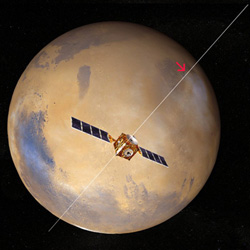
Mars Express and its 20-metre radar booms. Image credit: ESA. Click to enlarge.
Following in-depth analyses performed after the deployment of the first MARSIS antenna boom on board Mars Express, ESA has decided to proceed with the deployment of the second 20-metre antenna boom.
The full operation will be performed during a time frame starting 13 June and nominally ending on 21 June.
A delay in the execution of the second boom deployment was necessary, due to problems encountered with the first deployment in early May this year. During the deployment, one of the antenna hinges (the tenth) got stuck in an unlocked position. Analysis of data obtained from earlier ground testing suggested a potential solution.
The Mars Express spacecraft control team at ESA?s Spacecraft Operations Centre (ESOC) succeeded in unblocking the hinge by exposing the cold side of the boom to the Sun. This warmed the hinges and the boom quickly became unstuck. In the end, the first boom deployment was completed on 10 May.
The lessons learnt during the first boom deployment were used to run new simulations and determine a new deployment scenario for the second boom. This scenario contains an additional sun-heating phase, to get the best possible thermal conditions for all hinges.
The deployment of the third (7-metre) third MARSIS boom is not considered critical. It will be commanded only once the ESA ground control team have re-acquired signal from the spacecraft, and made sure with a sequence of tests that the second boom is correctly locked into position and the spacecraft is well under control.
After this event MARSIS, the Mars Express Sub-Surface Radar Altimeter, will enter into a commissioning phase for the next few weeks, before starting to look at Mars?s ionosphere during martian daylight, and to probe down below the Martian surface during the martian night.
Original Source: ESA News Release
Audio: Homing Beacon for an Asteroid
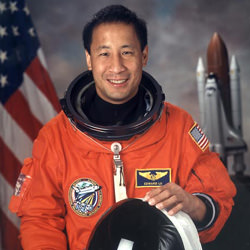
NASA Astronaut B612 Foundation director Dr. Edward Lu. Image credit: NASA
Listen to the interview: Homing Beacon for an Asteroid (6.2 mb)
Or subscribe to the Podcast: universetoday.com/audio.xml
Fraser Cain: Can you give me some background on the development of the B612 Foundation?
Dr. Edward Lu: It all started a few years back with a couple of different conversations I had with Piet Hut at the Institute for Advanced Studies, and a former astronaut called Rusty Schweickart. We were discussing the advances in high specific impulse propulsion, in other words ion propulsion or plasma propulsion, which is currently being worked on at NASA. We wondered, what could you use this for? One of the things that I’d been thinking about and discussed with various other people was the idea of pushing on an asteroid to demonstrate how this would work; to actually have a mission that would need this technology and would therefore drive you to complete the technology. Having a direct goal is the best way to get you to actually build something. The idea of moving an asteroid that something we’re eventually going to need to do, which is something that’s not possible using current chemical rockets. So we talked about that, and eventually we organized a meeting here at NASA of folks who work in the area of asteroids or working on spacecraft development. That was about 3-4 years ago. Everyone came down to NASA in Houston, and we talked about the idea and what it would take; how much thrust you would need, how much power you would need, how you could do such a thing. Our little foundation was an outgrowth of that meeting.
Fraser: You’ve set your sights on an asteroid that’s going to be swinging past the Earth in a couple of decades.
Lu: This is a proposal that’s been put forth by Rusty. This is an asteroid called 2004 MN4, which is going to make a very close flyby of the Earth in the year 2029 – it’s actually going to be about 4 Earth radii away, below the altitude of our geosynchronous satellites. It’s going to pass so close to the Earth that it’s going to take a pretty sharp bend in its trajectory. The problem is that where it goes after this flyby is really critically dependant on how close it comes to the Earth. It’s like a banked billiard shot. If you make a small error in a banked shot and you can have a big error where the ball goes after bouncing off of another ball. And that’s exactly what’s going on here. It turns out that our best guess at where it’s going to be when it comes by the Earth means that if there is a chance that 6-7 years later – either 2035 or 2036 – this thing could come back and actually hit the Earth. Now the chances are really small because we don’t have very good information on how close it’s going to be to the Earth. We only know its distance, how close it’s going to come to the Earth, by a factor of some thousands of miles. In order to know whether it’s going to come back and hit the Earth, you need to know accurately how close it’s going to come to the Earth to withing a factor of a few hundred metres, less than a kilometre. That’s why the best we can say is, oh, there’s some chance that it could hit us, but we just can’t simply say any better. What Rusty pointed out is that as the years go by, running up to 2029, this asteroid is going to go basically on the other side of the Sun. Its orbit is going to be on the other side of the Sun for some period of time. We’re going to lose track of it here in the next year or so. In which case, we won’t be able to pick it up again for another 6-7 years when it’s no longer orbiting the Sun, but on the other side of it. Its orbit will bring it back around our side of the Sun and we’ll pick it up again, and by then we’ll be able to determine its orbit more accurately, but the question is, will it be accurate enough to determine whether or not – after this slingshot when it comes by the Earth in 2029 – it will come hit us later.
Fraser: And you’re hoping if you can put some kind of tracking on the asteroid, then you’d be able to get it down within that few hundred metres distance.
Lu: Exactly, and the reason Rusty pointed out that’s it’s important to do it early is because, what if you find out that it is going to come back and hit us? If you’re going to do something about it, you would need to do something about it before 2029, before the close pass. And the reason is, again going back to a billiard shot, let’s say you’re taking a cue ball and trying to shoot it straight into a corner pocket. You can be a bit off in your aim and you can still hit that pocket pretty well. But not if you’re trying to hit another ball into the corner or do a bank shot where the cue ball bounces off something and then goes into the corner. Even a small error can mean you’re going to miss. So that’s both good and bad. If this thing is on a collision course, before 2029 you can upset it and keep it from going on a collision course by a very small change in its velocity. After 2029, it becomes very hard, in fact, more than likely not possible.
Fraser: I guess that’s one of my concerns in general about this whole process of detecting asteroids is that it’s all a world of probabilities. It’s not like it’s absolutely going to hit us on this date or anything. These are the chances of this asteroid, and those are the chances of that asteroid, and I wonder…
Lu: Well, it’s not really a matter of probability, that’s kind of a misnomer. Each one of these things either is going to hit us or it won’t. The reason you call it probability is because we can’t measure its exact trajectory well enough to say yes or no. That’s why we list it as probability. In the same way as: will it rain tomorrow. They say 30% chance of precipitation. It either is or isn’t going to rain, it’s just that we can’t tell you. In essence it’s like a weather forecast. And the accuracy with which you can measure the orbit, or the accuracy you can tell the weather, tells you how accurate your forecast is going to be. The forecast probability has nothing to do with the asteroid itself, it’s solely a matter of our telescopes.
Fraser: Right, and our techniques. What kind of mission would be involved to actually reach out and tap the asteroid?
Lu: First off, what’s actually been proposed is not to actually move it yet because the chances are that you won’t have to do it. What he’s actually proposing is that you put something on it that just simply measures where it is so you can tell for sure whether or not it’s going to hit or not. You want to know that early enough so that if it actually was coming, then you could do something about it. That’s what’s behind the idea of putting a transponder; all that is is a radio transmitter that you can measure exactly where it is. If you had to move it, that’s a whole other issue. But, the first thing is to know whether or not it’s even an issue or not.
Fraser: And so, what kind of mission would be involved to actually put the transmitter on the asteroid?
Lu: That’s something that would be a relatively simple mission, meaning all you have to do is get into the vicinity of it. You don’t even have to put down on it. Although, if you’re already going there, you might as well make this thing a very productive scientific mission because there’s plenty of things we can learn about asteroids. We’ve never visited a small asteroid. We’ve sent probes to much larger asteroids, hundreds of miles across, versus this one which is actually very small compared to those other ones – just a little over 300 metres across. Never having seen one of these things up close, obviously it could be a great scientific mission. What Rusty’s pointed out is that you kind of get two things here: number one, in the very unlikely case that this thing is going to hit us, this’ll tell you whether or not it will (more than likely not); but, if in fact it is not going to hit us, you have still put a very scientifically interesting mission out there. You can see what this thing is made of, what its surface structure is like, what it might be like to land on one of these things later, if you have to move another one. It tells you a lot about the properties of asteroids, so this thing doesn’t go to waste if you find, as it likely, that it’s not going to hit you.
Fraser: And what kind of time frame would you want to be able to launch it by?
Lu: You’d want to put it up something around the 2012/2013 time frame. And the reason is, again, you need lead time. Let’s say you put it up there in 2012 or 2013 and it takes a year or so to get there, and then you know within a year or so after that it is or isn’t going to hit you. Let’s say that you found out that it was going to hit you; well now it’s like 2015 at this point, and that gives you substantial 14 years to do something about it, before the close approach in 2029. Now you’re talking a much more ambitious mission, you’re talking a mission where you’re actually going to go push on this thing. That’s why you need the lead time. Something like that has never been tried before. It’s not something you can have an off the shelf spacecraft and say, well, we’ll just go ahead and launch it. It’s going to take some years to prepare the spacecraft, get it ready to launch, test it, and then fly it.
What’s Up This Week – June 6 – June 12, 2005
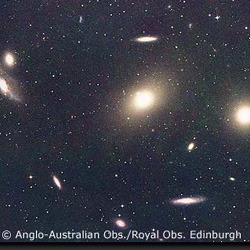
M84/86 Field Credit: David Malin. Click to enlarge.
Monday, June 6 – The Moon becomes New at 21:55 UT. Since our readers enjoy a challenge, there is a very specific galaxy hunt that I have in mind for you tonight. As part of Markarian’s Chain, this set of galaxies can all be fitted within the same field of view with a 32mm eyepiece and a 12.5″ scope. Because not everyone has the same equipment, it became a pet project of mine and co-observer Jeff Barbour to find out just how much of the “Field of Dreams” could be seen in other scopes. So set your sights toward the M84 and M85 and let’s discover!
Good binoculars, a 4.5″ reflector and a 80mm refractor reveals this pair with ease. The two galaxies appear as a matched set of ellipticals. On an exceptional night, a smaller scope will see that there is much more to this region. At 150mm, the western member of the pair – M84 is seen slightly brighter and visibly smaller. East and slightly north is M86. This galaxy’s nucleus is broader, and less intensely brilliant. It appears about one third larger than M84. In a 12.5″ scope, we see the galaxies literally “leap” out of the eyepiece at even the most modest magnifications. Strangely though, additional prominent structure fails to be seen.
Beginning at 6″ and increasing in aperture one of the most fascinating features of this area becomes apparent. While studying the bright galactic forms of the M84/86 with direct vision, aversion begins to welcome many other mysterious strangers into view. Forming an easy triangle with the two Messiers and located about 20 arc-minutes south lies NGC 4388. At magnitude 11.0. this edge-on spiral has dim star-like core to the 150mm, but a classic edge-on structure in larger scopes
At magnitude 12, NGC 4387 is located in the midst of a triangle formed of the two Messiers and NGC 4388. NGC 4387 is a dim galaxy a hint of a stellar nucleus to smaller scopes, while the larger scope sees a very small face-on spiral with a brighter nucleus. About 10 arc-minutes north of M86 is an even dimmer swatch of nebulosity – NGC 4402, which needs higher magnifications to be detected in a smaller scope. Large apertures at high power (300x) reveals a noticeable dust lane. The central structure forms a curved “bar” of light. Luminosity appears evenly distributed end to end, while the dust lane cleanly clips the classic central bulge of the core.
We’ve now gone as “deep” as we can. East of M86 are two brighter NGC galaxies – 4435 and 4438. Through a 6″ scope, NGC 4435 – is easily picked out at low power (50X) with a simple star-like core and wispy round body structure. NGC 4438 is dim, but even at 12.5″ in aperture, elliptical galaxies tend to be rather uninteresting creatures. The beauty of the NGC 4435 and NGC 4438 are simply their proximity to each other. The 4435 shows true elliptical structure, evenly illuminated – with a sense of fading toward the edges… But the 4438 is quite a different story! This elliptical is much more elongated. A highly conspicuous wisp of galactic material can be seen stretching back toward the brighter, nearby galaxy pair M84/86. Happy hunting!
Tuesday, June 7 – Late night SkyWatchers, be alert for the peak of the June Arietid meteor shower during the early morning hours. The radiant is in the constellation of Aries and the fall rate is about 30 per hour. Most are slow moving with some fireballs.
Shortly after sunset, check out the western skyline for a wonderful photographic opportunity. Around 30 to 45 minutes after sunset, you can find bright Venus just above the west-northwest horizon. Scan the area about another fist-width to the planet’s right, and slightly lower for a tender sliver of light. Because the Moon sets a little more than an hour after sunset, timing is critical. Bring your binoculars!
Are you watching Comet 9/P Tempel 1? The time for Deep Impact is getting closer, folks. Still requiring a larger scope, you’ll find the comet around 8 degrees west of Zeta Virginis. Coordinates show a rough position of RA 13:00:71 and Dec +01.02.2. For those with GoTo capabilities, head for NGC 4904 and go north slightly more than a degree.
Wednesday, June 8 – If you haven’t checked on Saturn lately, tonight would be a reason to observe and celebrate. Born on this date in 1625 was Giovanni Cassini – the most notable observer following Galileo. As head of the Paris Observatory for many years, he was the first to observe seasonal changes on Mars and measure its parallax (or distance). This set the scale of the solar system for the first time. Cassini was the first to describe Jovian features, and studied the galiean moons’ orbits. He also discovered four moons of Saturn, but he is best remembered for being the first to see the his namesake division between the A and B rings. Suppose we should name a spacecraft after him?
Tonight the slender Moon will be half a fist-width above Venus. The twilight sky will offer a wonderful opportunity to visualize the ecliptic plane as Saturn appears less than a handspan to the upper left of Selene. If you are out at sunset, look at the point where the Sun disappeared on the horizon with binoculars and you may have a chance to spot Mercury about a fist width to the lower right of Venus. Can you complete the picture by spotting Jupiter as well?
Thursday, June 9 – Today is the birthday of Johann Gottfried Galle. Born in Germany in 1812, Galle was the first observer to locate Neptune. He is also known for being Encke’s assistant – and he’s one of the few astronomers ever to have observed Halley’s Comet twice. Unfortunately, he died two months after the comet passed perihelion in 1910, but at a ripe old age of 98!
Want to practice some astronomy during the day? Then grab an FM radio and enjoy as we are entering some of the strongest daytime radio meteor showers of the year. All you need is an external antenna. Tune the receiver to the lowest frequency that does not produce a clear signal. Each time a meteor passes through our atmosphere, it leaves an ion trail that bounces back distant radio signals to you – even in a stationary car! Listen to the static for a quick rise in volume or a snatch of a distant station that lasts a second or two followed by a fade.
Tonight the more prominent crescent Moon will appear between Castor, Pollux and Saturn. Look for shallow old crater Langrenus just south of central on the limb.
Friday, June 10 – Since next week’s studies will deal mainly with lunar features, let’s try a deep sky object that will show easily despite tonight’s crescent Moon – M13. To help beginner’s recognize the “Keystone” of Hercules, look between bright orange Arcturus overhead and equally bright Vega to the east. You are looking for a lopsided rectangle of stars that are very similar in magnitude and narrow to the south. This “shape” can easily be covered by holding out your closed fist. Look at the top (western-most) two stars – Eta and Zeta – and draw an imaginary line between them. By starting with the northern-most (or top left of the four) move 1/3 the distance along your line and aim your binoculars or telescopes there.
Originally discovered in in 1715, and cataloged in 1764 by Charles Messier, the M13 can only be rivaled by Omega Centauri as the grandest globular cluster in the night sky. This pure population II system contains over 30,000 stars! Enjoy it tonight, and we will return in the weeks ahead to study this incredible object.
Saturday, June 11 – If you haven’t spotted Mercury yet, try again tonight as it climbs toward Venus while Venus moves toward Saturn. Begin watching all three of these planets as a group, because something very cool is about to happen. The trio now covers slightly more than a handspan of sky, but are moving toward a splendid conjunction that will put them about a thumb’s width apart! Mark your calendars now for June 25 and tell your family and friends to watch as the planets dance closer and closer together each night…
Sunday, June 12 – Tonight the Moon very near Regulus, heart of Leo. Can you pick the star out with just your eyes? If you have binoculars, tonight will be your opportunity to spot shallow crater Posidonius along the terminator to the north and the three rings of Theophilus, Cyrillus and Catherina to the south.
If you are out after the Moon sets tonight, keep watch for the peak of the Ophiuchids meteor shower with the radiant near the rising Scorpius. The fall rate is poor with only 3 per hour but fast moving bolides are common. The duration of this meteor stream will last for 25 days.
Even if you have a busy schedule ahead, just watch the movements of the planets as they draw closer over the coming nights. Until next week? Keep your eyes on the skies and may all your journeys be at Light Speed! …~Tammy Plotner
Book Review: The Real Space Cowboys
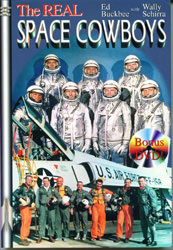
Ed Buckbee started working for NASA in 1959 and was eventually a public affairs officer for the Mercury and other programs. He has kept involved with the United States and international space program. He is also the founder of Space Camp, an educational facility for young want-to-be astronauts. Wally Schirra is one of the original seven astronauts, known as the Mercury Seven. He flew in the Mercury, Gemini and Apollo programs. Given this involvement and their obvious continual passion for space, their book is filled with vivid memories and thoughtful recollections of many of the most well known participants, such as Alan Shepard, John Glenn and Werhner von Braun. Through the judicious use of quotations and well detailed settings, this book brings to life many memorable and probably unknown personal events.
As with any diary, this book journeys down memory lane. The topics flow through chronologically from about the early 1960’s when a squirrel monkey named Miss Baker went into orbit. It ends with taikonauts and the rising stars of Space Camp. Details of bathroom pranks, rocket men in cowboy hats and turtle club antics show an inclination less to factual dissertations and more to the warmer, funny side of things. Most of the writing seems to come from Buckbee’s own experiences. However many quotes, mainly from the Mercury 7 astronauts, bring to life other participants’ feelings regarding space flight, tragedies and hard work. Further, Buckbee has added many photographs of relevant people (and himself) at auspicious occasions. From it all, the message conveys an appreciation of the continual overwork, levity and trepidation that was part of the astronauts’ everyday lives at the forefront of technology.
Separate chapters focus uniquely on each of the Mercury Seven. These principally have direct quotes from those alive or fond remembrances of colleagues since gone. President Kennedy, a recognized driving force for the program, has a chapter that focuses on his involvement. The chapter of Wernher von Braun, the rocket man spirited over from Germany after the end of World War II, highlights his views on travelling to Mars. Most of all though, Alan Shepard’s memories, spirited ‘gotcha’s, and contributions predominate, including a touching memorial to him and his wife Louise. Though not all these people personified the traditional cowboy, they certainly were significant figures in the U.S.’s space program.
Recorded on a DVD attached to the back is a collection of videos. These range from documentaries, to conferences and onto joke films all directly or closely related to the Mercury astronauts. A film clip of Schirra’s ‘roasts’ Shepard after his flight into space. Some rather dry conferences with question and answer periods show astronauts responding to questions from the public. Documentaries, such as the one of Skylab, show the glossy period pieces. Whether for propaganda purposes, advertising or simple stress relief, each film clip adds to the people and events of the book.
The title reference to cowboys presumably acknowledges the typical traits of the astronauts. Or, it is a reference to a picture of Schirra ‘riding’ his Sigma 7 Mercury spacecraft at a museum. Whichever, the book never defines the traits of a cowboy nor how the astronauts had similarities. Nor does the issue of real versus fake appear. Perhaps Buckbee was alluding to the astronauts independence and self confidence which does manifest itself. In addition, the book has the feel of coming from a public relations department. This is not all that bad, as the perspective is unique and close to the action. However, everything has a very positive spin. From this perspective, all the people worked hard, did great deeds and never seemed to have any of the common human failings. Perhaps this is the greatest discrepancy as there are many unpleasantries and failures associated with cowboys of the wild west.
A diary, like this book, is a fun trip down memory lane. The Real Space Cowboys a book by Ed Buckbee with Wally Schirra provides this trip. And coming from the NASA public relations official involved with the program and an astronaut, you can be certain it provides a complimentary, close-in perspective. This together with the many photographs and the included film footage makes travelling this lane a joy.
Read more reviews or order a copy online from Amazon.com
Review by Mark Mortimer
Supernova Left No Core Behind
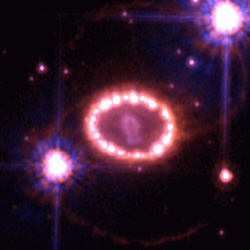
The 1987A supernova remnant doesn’t seem to have a neutron star. Image credit: Hubble. Click to enlarge.
In 1987, earthbound observers saw a star explode in the nearby dwarf galaxy called the Large Magellanic Cloud. Astronomers eagerly studied this supernova-the closest seen in the past 300 years-and have continued to examine its remains. Although its blast wave has lit up surrounding clouds of gas and dust, the supernova appears to have left no core behind. Astronomers now report that even the sharp eyes of the Hubble Space Telescope failed to locate the black hole or ultracompact neutron star they believe was created by the star’s death 18 years ago.
“We think a neutron star was formed. The question is: Why don’t we see it?” said astronomer Genevieve Graves of UC Santa Cruz, first author on the paper announcing these results.
“Therein lies the mystery-where is that missing neutron star?” mused co-author Robert Kirshner of the Harvard-Smithsonian Center for Astrophysics (CfA).
When a massive star explodes, it leaves behind some sort of compact object, either a city-sized ball of subatomic particles called a neutron star, or a black hole. The outcome depends on the mass of the progenitor star. Smaller stars form neutron stars while larger stars form black holes.
The progenitor of supernova (SN) 1987A weighed 20 times as much as the sun, placing it right on the dividing line and leaving astronomers uncertain about what type of compact object it produced. All observations to date have failed to detect a light source in the center of the supernova remnant, leaving the question of the outcome unanswered.
Detecting a black hole or neutron star is challenging. A black hole can be detected only when it swallows matter, because the matter heats up and emits light as it falls into the black hole. A neutron star at the distance of the Large Magellanic Cloud can be detected only when it emits beams of radiation as a pulsar, or when it accretes hot matter like a black hole.
“A neutron star could just be sitting there inside SN 1987A, not accreting matter and not emitting enough light for us to see,” said astronomer Peter Challis (CfA), second author on the study.
Observations have ruled out the possibility of a pulsar within SN 1987A. Even if the pulsar’s beams were not aimed at the earth, they would light the surrounding gas clouds. However, theories predict that it can take anywhere from 100 to 100,000 years for a pulsar to form following a supernova, because the neutron star must gain a sufficiently strong magnetic field to power the pulsar beam. SN 1987A may be too young to hold a pulsar.
As a result, the only way astronomers might detect the central object is to search for evidence of matter accreting onto either a neutron star or a black hole. That accretion could happen in one of two ways: spherical accretion in which matter falls in from all directions, or disk accretion in which matter spirals inward from a disk onto the compact object.
The Hubble data rule out spherical accretion because light from that process would be bright enough to detect. If disk accretion is taking place, the light it generates is very faint, meaning that the disk itself must be quite small in both mass and radial extent. Also, the lack of detectable radiation indicates that the disk accretion rate must be extremely low-less than about one-fifth the mass of the Moon per year.
In the absence of a definitive detection, astronomers hope to learn more about the central object by studying the dust clouds surrounding it. That dust absorbs visible and ultraviolet light and re-radiates the energy at infrared wavelengths.
“By studying that reprocessed light, we hope to find out what’s powering the supernova remnant and lighting the dust,” said Graves. Future observations by NASA’s Spitzer Space Telescope should provide new clues to the nature of the hidden object.
Additional observations by Hubble also could help solve the mystery. “Hubble is the only existing facility with the resolution and sensitivity needed to study this problem,” said Kirshner.
The paper describing these findings is online at http://arxiv.org/abs/astro-ph?0505066
Original Source: CfA News Release
Opportunity Rolls Free from the Dune
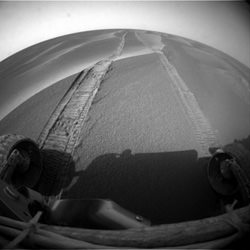
A view back into the sand dune that had captured Opportunity. Image credit: NASA/JPL. Click to enlarge.
NASA’s Mars Exploration Rover mission engineers and managers cheered when images from the Martian surface confirmed Opportunity successfully escaped from a sand trap.
From about 108 million miles away, the rover team at NASA’s Jet Propulsion Laboratory (JPL), Pasadena, Calif., had worked diligently for nearly five weeks to extricate the rover. The long-distance roadside assistance was a painstaking operation to free the six wheeled rover, which was mired in the soft sand of a small Martian dune.
“After a nerve wracking month of hard work, the rover team is both elated and relieved to finally see our wheels sitting on top of the sand instead of half buried in it,” said Jeffrey Biesiadecki, a JPL rover mobility engineer.
Traction was difficult in the ripple-shaped dune of windblown dust and sand that Opportunity drove into on April 26. In the weeks following, the rover churned 629 feet worth of wheel rotations before gaining enough traction to actually move three feet. The rover team directed the drives in cautious increments from May 13 through last Saturday.
“We did careful testing for how to get Opportunity out of the sand. Then we patiently followed the strategy developed from the testing, monitoring every step of the way,” Biesiadecki said. “We hope to have Opportunity busy with a full schedule of scientific exploration again shortly,” he added.
Opportunity’s next task is to examine the site to provide a better understanding of what makes that ripple different from the dozens of similar ones the rover easily crossed. “After we analyze this area, we’ll be able to plan safer driving in the terrain ahead,” said JPL’s Jim Erickson, rover project manager.
Both Spirit and Opportunity have worked in harsh Martian conditions much longer than anticipated. They have been studying geology on opposite sides of Mars for more than a year of extended missions since successfully completing their three-month primary missions in April 2004.
“The first thing we’re going to do is simply take a hard look at the stuff we were stuck in,” said Dr. Steve Squyres of Cornell University, Ithaca, N.Y. He is the principal investigator for the Mars rovers’ science instruments. “After that, we will begin a cautious set of moves to get us on our way southward again. South is where we think the best science is, so that’s still where we want to go,” he added.
Shortly after landing in January 2004, Opportunity found layered bedrock that bore geological evidence for a shallow ancient sea. Spirit did not find extensive layered bedrock until more than a year later, after driving more than two miles and climbing into a range of hills known as “Columbia Hills.”
Original Source: NASA News Release
Strange Ozone Hole this Year
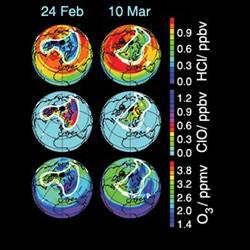
Changing ozone hole. Image credit: NASA/JPL. Click to enlarge.
Despite near-record levels of chemical ozone destruction in the Arctic this winter, observations from NASA’s Aura spacecraft showed that other atmospheric processes restored ozone amounts to near average and stopped high levels of harmful ultraviolet radiation from reaching Earth’s surface.
Analyses from Aura’s Microwave Limb Sounder indicated Arctic chemical ozone destruction this past winter peaked at near 50 percent in some regions of the stratosphere, a region of Earth’s atmosphere that begins about 8 to 12 kilometers (5 to 7 miles) above Earth’s poles. This was the second highest level ever recorded, behind the 60 percent level estimated for the 1999-2000 winter. Data from another instrument on Aura, the Ozone Monitoring Instrument, found the total amount of ozone over the Arctic this past March was similar to other recent years when much less chemical ozone destruction occurred. So what tempered the ozone loss? The answer appears to lie in this year’s unusual Arctic atmospheric conditions.
“This was one of the most unusual Arctic winters ever,” said scientist Dr. Gloria Manney of NASA’s Jet Propulsion Laboratory, Pasadena, Calif., who led the Microwave Limb Sounder analyses. “Arctic lower stratospheric temperatures were the lowest on record. But other conditions like wind patterns and air motions were less conducive to ozone loss this year.”
While the Arctic polar ozone was being chemically destroyed toward the end of winter, stratospheric winds shifted and transported ozone-rich air from Earth’s middle latitudes into the Arctic polar region, resulting in little net change in the total amount of ozone. As a result, harmful ultraviolet radiation reaching Earth’s surface remained at near-normal levels.
Imagery and an animation depicting the Microwave Limb Sounder and Ozone Monitoring Instrument 2005 Arctic ozone observations may be viewed at:
http://www.nasa.gov/vision/earth/lookingatearth/ozone-aura.html
Extensive ozone loss occurs each winter over Antarctica (the “ozone hole”) due to the extreme cold there and its strong, long-lived polar vortex (a band of winds that forms each winter at high latitudes). This vortex isolates the region from middle latitudes. In contrast, the Arctic winter is warmer and its vortex is weaker and shorter-lived. As a result, Arctic ozone loss has always been lower, more variable and much more difficult to quantify.
This was the first Arctic winter monitored by Aura, which was launched in July 2004. Aura’s Microwave Limb Sounder is contributing to our understanding of the processes that cause Arctic wind patterns to push ozone-rich air to the Arctic lower stratosphere from higher altitudes and lower latitudes. Through Aura’s findings, scientists can differentiate chemical ozone destruction from ozone level changes caused by air motions, which vary dramatically from year to year.
“Understanding Arctic ozone loss is critical to diagnosing the health of Earth’s ozone layer,” said Dr. Phil DeCola, Aura program scientist at NASA Headquarters, Washington. “Previous attempts to quantify Arctic ozone loss have suffered from a lack of data. With Aura, we now have the most comprehensive, simultaneous, global daily measurements of many of the key atmospheric gases needed to understand and quantify chemical ozone destruction.”
Ozone loss in Earth’s stratosphere is caused primarily by chemical reactions with chlorine from human-produced compounds like chlorofluorocarbons. When stratospheric temperatures drop below minus 78 degrees Celsius (minus 108 degrees Fahrenheit), polar stratospheric clouds form. Chemical reactions on the surfaces of these clouds activate chlorine, converting it into forms that destroy ozone when exposed to sunlight.
The data obtained by Aura were independently confirmed by instruments participating in NASA’s Polar Aura Validation Experiment, which flew underneath Aura as it passed over the polar vortex. The experiment, flown on NASA’s DC-8 flying laboratory from NASA’s Dryden Flight Research Center, Edwards, Calif., carried 10 instruments to measure temperatures, aerosols, ozone, nitric acid and other gases. The experiment was carried out in January and February 2005.
Aura is the third and final major Earth Observing System satellite. Aura carries four instruments: the Ozone Monitoring Instrument, built by the Netherlands and Finland in collaboration with NASA; the High Resolution Dynamics Limb Sounder, built by the United Kingdom and the United States; and the Microwave Limb Sounder and Tropospheric Emission Spectrometer, both built by JPL. Aura is managed by NASA’s Goddard Space Flight Center, Greenbelt, Md.
For more information on Aura on the Internet, visit: http://aura.gsfc.nasa.gov/
For more information on the Microwave Limb Sounder on the Internet, visit: http://mls.jpl.nasa.gov/
JPL is managed for NASA by the California Institute of Technology in Pasadena.
Original Source: NASA/JPL News Release
View Through the Rings
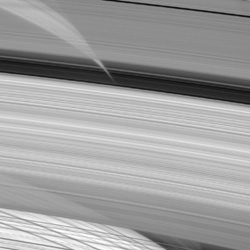
Cassini’s beautiful view of Saturn, looking through its rings. Image credit: NASA/JPL/SSI. Click to enlarge.
In this fabulous close-up, Cassini peers directly through regions of the A, B and C rings (from top to bottom here) to glimpse shadows of the very same rings cast upon the planet’s atmosphere. Near the top, shadows cast by ringlets in the Cassini division (center) look almost like a photo negative.
This type of image helps scientists probe the rings’ structure in detail and provides information about the density of their constituent particles.
The image was taken in visible light with the Cassini spacecraft narrow-angle camera on April 26, 2005, at a distance of approximately 2.3 million kilometers (1.4 million miles) from Saturn. The image scale is 14 kilometers (9 miles) per pixel.
The Cassini-Huygens mission is a cooperative project of NASA, the European Space Agency and the Italian Space Agency. The Jet Propulsion Laboratory, a division of the California Institute of Technology in Pasadena, manages the mission for NASA’s Science Mission Directorate, Washington, D.C. The Cassini orbiter and its two onboard cameras were designed, developed and assembled at JPL. The imaging team is based at the Space Science Institute, Boulder, Colo.
For more information about the Cassini-Huygens mission visit http://saturn.jpl.nasa.gov . For additional images visit the Cassini imaging team homepage http://ciclops.org .
Original Source: NASA/JPL/SSI News Release
Mars Phoenix Mission Prepares for 2007 Launch
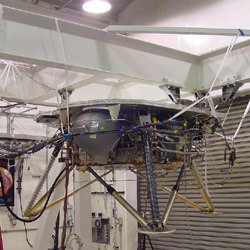
A mock up of the Phoenix lander. Image credit: NASA/Lockheed Martin. Click to enlarge.
NASA has given the green light to a project to put a long-armed lander on to the icy ground of the far-northern Martian plains. NASA’s Phoenix lander is designed to examine the site for potential habitats for water ice, and to look for possible indicators of life, past or present.
Today’s announcement allows the Phoenix mission to proceed with preparing the spacecraft for launch in August 2007. This major milestone followed a critical review of the project’s planning progress and preliminary design, since its selection in 2003.
Phoenix is the first project in NASA’s Mars Scout Program of competitively selected missions. Scouts are innovative and relatively low-cost complements to the core missions of the agency’s Mars exploration program.
“The Phoenix Mission explores new territory in the northern plains of Mars analogous to the permafrost regions on Earth,” said the project’s principal investigator, Peter Smith of the University of Arizona, Tucson. “NASA’s confirmation supports this project and may eventually lead to discoveries relating to life on our neighboring planet.”
Phoenix is a stationary lander. It has a robotic arm to dig down to the Martian ice layer and deliver samples to sophisticated analytical instruments on the lander’s deck. It is specifically designed to measure volatiles, such as water and organic molecules, in the northern polar region of Mars. In 2002, NASA’s Mars Odyssey orbiter found evidence of ice-rich soil very near the surface in the arctic regions.
Like its namesake, Phoenix rises from ashes, carrying the legacies of two earlier attempts to explore Mars. The 2001 Mars Surveyor lander, administratively mothballed in 2000, is being resurrected for Phoenix. Many of the scientific instruments for Phoenix were built or designed for that mission or flew on the unsuccessful Mars Polar Lander in 1999.
“The Phoenix team’s quick response to the Odyssey discoveries and the cost-saving adaptation of earlier missions’ technology are just the kind of flexibility the Mars Scout Program seeks to elicit,” said NASA’s Mars Exploration Program Director, Doug McCuistion.
“Phoenix revives pieces of past missions in order to take NASA’s Mars exploration into an exciting future,” said NASA’s Director, Solar System Division, Science Mission Directorate, Andrew Dantzler.
The cost of the Phoenix mission is $386 million, which includes the launch. The partnership developing the Phoenix mission includes the University of Arizona; NASA’s Jet Propulsion Laboratory (JPL), Pasadena, Calif.; Lockheed Martin Space Systems, Denver; and the Canadian Space Agency, which is providing weather-monitoring instruments.
“The confirmation review is an important step for all major NASA missions,” said JPL’s Barry Goldstein, project manager for Phoenix. “This approval essentially confirms NASA’s confidence that the spacecraft and science instruments will be successfully built and launched, and that once the lander is on Mars, the science objectives can be successfully achieved.”
Much work lies ahead. Team members will assemble and test every subsystem on the spacecraft and science payload to show they comply with design requirements. Other tasks include selecting a landing site, which should be aided by data provided by the Mars Reconnaissance Orbiter launching in August, and preparing to operate the spacecraft after launch.
JPL, a division of the California Institute of Technology, Pasadena, manages Phoenix for NASA’s Science Mission Directorate.
Original Source: NASA/JPL News Release
